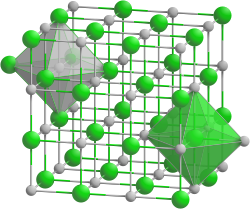Lead selenide
| Crystal structure | |||||||||||||||||||
|---|---|---|---|---|---|---|---|---|---|---|---|---|---|---|---|---|---|---|---|

|
|||||||||||||||||||
| __ Pb 2+ __ Se 2− | |||||||||||||||||||
| General | |||||||||||||||||||
| Surname | Lead selenide | ||||||||||||||||||
| other names |
Lead (II) selenide |
||||||||||||||||||
| Ratio formula | PbSe | ||||||||||||||||||
| Brief description |
gray powder |
||||||||||||||||||
| External identifiers / databases | |||||||||||||||||||
|
|||||||||||||||||||
| properties | |||||||||||||||||||
| Molar mass | 286.16 g mol −1 | ||||||||||||||||||
| Physical state |
firmly |
||||||||||||||||||
| density |
8.1 g cm −3 at 25 ° C |
||||||||||||||||||
| Melting point |
1080.7 ° C |
||||||||||||||||||
| solubility |
|
||||||||||||||||||
| safety instructions | |||||||||||||||||||
|
|||||||||||||||||||
| As far as possible and customary, SI units are used. Unless otherwise noted, the data given apply to standard conditions . | |||||||||||||||||||
Lead selenide is a chemical compound of lead from the selenide group .
Occurrence
Lead selenide occurs naturally in the form of the mineral clausthalite .
Extraction and presentation
Lead selenide can be obtained through a multi-stage reaction of selenium with nitric acid , ammonia and lead (II) oxide .
The synthesis is also possible by converting equimolar amounts of lead (II) acetate trihydrate Pb (CH 3 CO 2 ) 2 · 3H 2 O and selenous acid H 2 SeO 3 to lead selenite PbSeO 3 and its subsequent reduction with a weakly acetic acid Solution of hydrazine N 2 H 4 .
The synthesis of lead selenide single crystals takes place from exactly stoichiometric amounts of the two elements in quartz ampoules under vacuum.
properties
Lead selenide is a gray to black crystalline powder which has semiconductor properties and is insoluble in water. It is soluble in hydrochloric acid and nitric acid with chemical change. The crystals are outwardly galena similar and with it isomorphic (B 1 type, a = 6.124 A). When heated in an open test tube, lead selenide decomposes with the development of selenium vapors.
use
Lead selenide is used as a semiconductor detector in thermal imaging cameras and radiation receivers ( pyrometers ) in the spectral range from 1 to 5 µm. It is also used as a material for laser diodes (with small additions of strontium, europium or tin selenide ) in the range from 3 to 25 µm.
literature
- Sm Kulifay, J. Inorg Nucl. Chem. 25, 75 (1963).
- Constanze Vaupel, Synthesis of lead sulfide nanostructures and hetero systems (PDF; 5.6 MB)
Individual evidence
- ↑ a b c d data sheet Lead (II) selenide from Sigma-Aldrich , accessed on May 7, 2011 ( PDF ).
- ↑ a b c d e Georg Brauer (Ed.), With the collaboration of Marianne Baudler u. a .: Handbook of Preparative Inorganic Chemistry. 3rd, revised edition. Volume II, Ferdinand Enke, Stuttgart 1978, ISBN 3-432-87813-3 , p. 779.
- ^ Mineralienatlas: Clausthalit
- ↑ toilet Benzig, JB Conn JV Magee u. EJ Shehaan, J. Amer. Chem. Soc. 80, 2657 (1958).
- ↑ D. Seidmann, I. Cadott, K. Komarek a. E. Miller, Trans. AIME 221: 1269 (1961); WD Lawson et al. S. Nielsen, Preparation of Single Crystals, Butterworths, London 1958, pp. 141 ff.
- ↑ Laser Components: 4-channel lead selenide detector
- ↑ Laser components: Laser sources ( Memento of the original from March 5, 2016 in the Internet Archive ) Info: The archive link was inserted automatically and has not yet been checked. Please check the original and archive link according to the instructions and then remove this notice. (PDF; 456 kB)







